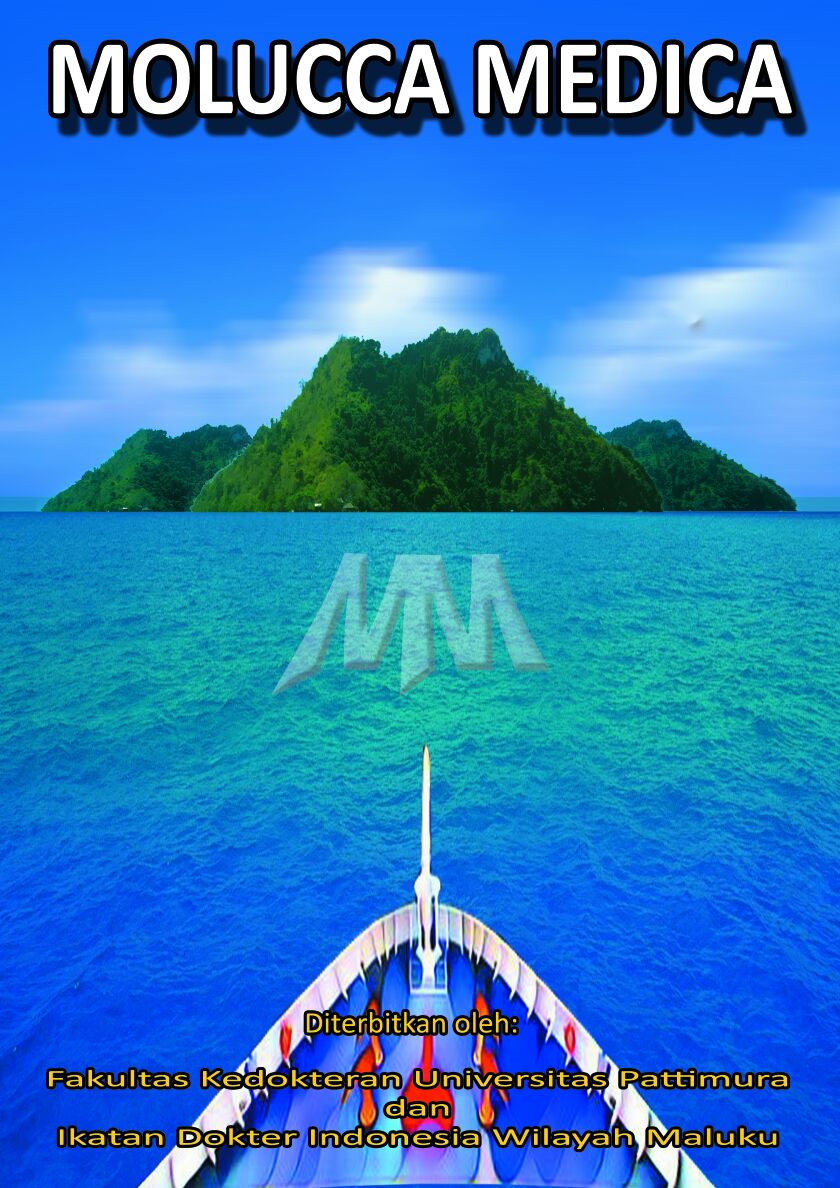THE EARLY DETECTION OF METABOLIC SYNDROME USED NCEP ATP-III METHOD IN WAAI VILLAGE COMMUNITY CENTRAL MALUKU REGENCY
Abstract
Metabolic syndrome is a metabolic disorder that complexly includes carbohydrate, lipid and protein metabolism disorders which are known to be the main cause of diabetes mellitus, hypertension and coronary heart disease. Waai Village, Central Maluku Regency is one of the villages affected by the earthquake for a long time so that social assistance in the form of fast food is consumed in the long term which is thought to be one of the causes of metabolic syndrome. The purpose of this research is to detect the presence of metabolic syndrome with the NCEP ATP-III criteria consists of measuring blood pressure, fasting blood glucose levels and serum triglyceride levels using the photometric method. This type of research is descriptive research with a cross sectional approach. The sampling technique used is purposive sampling, in accordance with the predetermined sample criteria. The results showed that 29 of 50 subjects (58%) had metabolic syndrome with an average blood pressure of 148/94 mmHg, an average fasting blood glucose level of 158 mg/dL, and an average triglyceride level of 198 mg/dL.
Downloads
References
2. Ford, E.S., et al. (2015). Prevalence of the metabolic syndrome defined by the International Diabetes Federation among adults in the U.S. Diabetes Care 2005;28;2745-49.
3. International Diabetes Federation (IDF). (2018). Information on the IDF consensus worldwide definition of the metabolic syndrome. 2018 [internet]. Available from: http://www.idf.org/webdata/docs/IDF_Meta_def_final.pdf
4. National Cholesterol Education Program/ Adult Treatment Panel III (NCEP/ATP III). (2018). Adult Treatment Panel III. Expert panel on detection, evaluation, and treatment of high blood cholesterol in adults. Executive Summary of the Third Report of the National Cholesterol Education Program (NCEP) Expert Panel on Detection, Evaluation, and Treatment of High Blood Cholesterol in Adults (Adult Treatment Panel III). Journal American Medical Association. 2018;285(16):2486-96.
5. Wulandari, M.Y., Atoillah, M., Isfandiari. (2013). Sindrom metabolik dan gaya hidup dengan gejala komplikasi mikrovaskuler. Jurnal Berkala Epidemiologi. 2013;1(2):224-33
6. Magdalena., Mahpolah., Yusuf, A. (2016). Faktor faktor yang berhubungan dengan sindrom metabolik pada penderita rawat jalan di RSUD Ulin Banjarmasin. Jurnal Skala Kesehatan; 2016;(2). https://doi.org/10.31964/jsk.v5i2.16
7. Driyah, S., dkk. (2019). Prediktor sindrom metabolik: Studi kohor perspektif selama enam tahun di Bogor, Indonesia. Media Litbangkes, Vol.29 No.3, September 2019,215–224. https://doi.org/10.22435/mpk.v29i3.654
8. Ganong, W. F., 2008. Buku Ajar Fisiologi Kedokteran. Edisi 22. Jakarta : EGC , 280- 81.
9. James, P.A., Oparil, S., Carter, B.L., Cushman, W.C., Dennison-Himmelfarb, C.I., Handler, J., et al. (2014). 2014 Evidenced Based Guideline for the Management of High Blood Pressure In Adults Report From the Panel Members Appointed to The Eight Joint National Committee (JNC 8), Clinical Reviev & Education. JAMA, 311 (5), 507-520.
10. Wahyuningsih, N., dkk. (2016). Modul Paket Keahlian Analis Kesehatan. Kementerian Pendidikan dan Kebudayaan Direktorat Jenderal Pendidikan Guru dan Tenaga Kependidikan.
11. Human® Kit Insert. 2021. Pemeriksaan Glukosa darah dan Trigliserida Serum
12. PERKENI. (2015). Konsensus Pengelolaan dan Pencegahan Diabetes Melitus Tipe 2 di Indonesia 2019.
13. Suhaema., Masthalina, H. (2015). Pola konsumsi dengan terjadinya sindrom metabolik di Indonesia. Kesmas Nasional. 2015;9(4):340- 7.
14. Feryadi, R., Sulastri, D., & Kadri H. (2014). Hubungan kadar profil lipid dengan kejadian hipertensi pada masyarakat etnik Minangkabau di Kota Padang Tahun 2012. Jurnal Kesehatan Andalas. 2014;3 (2):206-12.
15. Subash, V., Kumar, A., Nagesh, M., et al. (2013). Incidence of metabolic syndrome and its characteristics of patients attending a diabetic outpatient clinic in a tertiary care ospital. J nat Sc I Biol Med. 2013;4(1):57–62.
16. Pandit, K., Goswami, S., Ghosh, S., et al. (2012). Metabolic syndrome in South Asians. Indian Journal of Endocrinology and Metabolism. 2012;16(1): 44-55.
17. Klop B, Elte JWF, Cabezas MC. Dyslipidemia in obesity: mechanisms and potential targets. Nutrients. 2013;5(4):1218-40
18. Franssen R, Monajemi H, Stroes E. Obesity and dyslipidemia. Endocrinology and Metabolism Clinics of North America. 2008;37:623-33.
Copyright (c) 2022 Molucca Medica

This work is licensed under a Creative Commons Attribution-NonCommercial-ShareAlike 4.0 International License.


